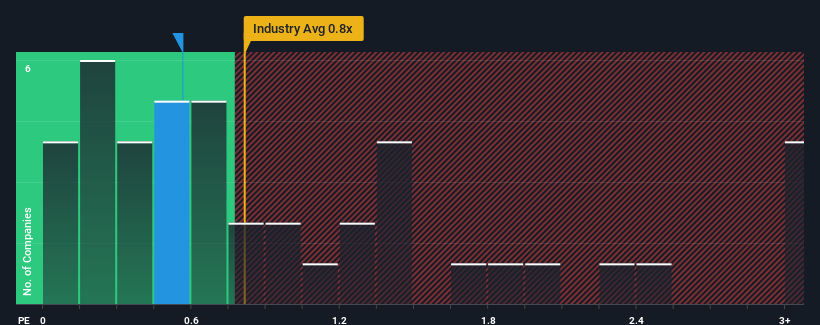Investors Interested In Cathay Pacific Airways Limited's (HKG:293) Revenues

With a median price-to-sales (or "P/S") ratio of close to 0.8x in the Airlines industry in Hong Kong, you could be forgiven for feeling indifferent about Cathay Pacific Airways Limited's (HKG:293) P/S ratio of 0.6x. However, investors might be overlooking a clear opportunity or potential setback if there is no rational basis for the P/S.
View our latest analysis for Cathay Pacific Airways

What Does Cathay Pacific Airways' P/S Mean For Shareholders?
Recent revenue growth for Cathay Pacific Airways has been in line with the industry. Perhaps the market is expecting future revenue performance to show no drastic signs of changing, justifying the P/S being at current levels. Those who are bullish on Cathay Pacific Airways will be hoping that revenue performance can pick up, so that they can pick up the stock at a slightly lower valuation.
If you'd like to see what analysts are forecasting going forward, you should check out our free report on Cathay Pacific Airways.Do Revenue Forecasts Match The P/S Ratio?
In order to justify its P/S ratio, Cathay Pacific Airways would need to produce growth that's similar to the industry.
If we review the last year of revenue growth, the company posted a terrific increase of 85%. The latest three year period has also seen an excellent 101% overall rise in revenue, aided by its short-term performance. So we can start by confirming that the company has done a great job of growing revenue over that time.
Turning to the outlook, the next three years should generate growth of 11% each year as estimated by the analysts watching the company. That's shaping up to be similar to the 12% per annum growth forecast for the broader industry.
With this information, we can see why Cathay Pacific Airways is trading at a fairly similar P/S to the industry. It seems most investors are expecting to see average future growth and are only willing to pay a moderate amount for the stock.
What Does Cathay Pacific Airways' P/S Mean For Investors?
While the price-to-sales ratio shouldn't be the defining factor in whether you buy a stock or not, it's quite a capable barometer of revenue expectations.
A Cathay Pacific Airways' P/S seems about right to us given the knowledge that analysts are forecasting a revenue outlook that is similar to the Airlines industry. Right now shareholders are comfortable with the P/S as they are quite confident future revenue won't throw up any surprises. Unless these conditions change, they will continue to support the share price at these levels.
It is also worth noting that we have found 3 warning signs for Cathay Pacific Airways (1 is a bit concerning!) that you need to take into consideration.
If strong companies turning a profit tickle your fancy, then you'll want to check out this free list of interesting companies that trade on a low P/E (but have proven they can grow earnings).
New: AI Stock Screener & Alerts
Our new AI Stock Screener scans the market every day to uncover opportunities.
• Dividend Powerhouses (3%+ Yield)
• Undervalued Small Caps with Insider Buying
• High growth Tech and AI Companies
Or build your own from over 50 metrics.
Have feedback on this article? Concerned about the content? Get in touch with us directly. Alternatively, email editorial-team (at) simplywallst.com.
This article by Simply Wall St is general in nature. We provide commentary based on historical data and analyst forecasts only using an unbiased methodology and our articles are not intended to be financial advice. It does not constitute a recommendation to buy or sell any stock, and does not take account of your objectives, or your financial situation. We aim to bring you long-term focused analysis driven by fundamental data. Note that our analysis may not factor in the latest price-sensitive company announcements or qualitative material. Simply Wall St has no position in any stocks mentioned.
About SEHK:293
Cathay Pacific Airways
Offers international passenger and air cargo transportation services.
Undervalued average dividend payer.


